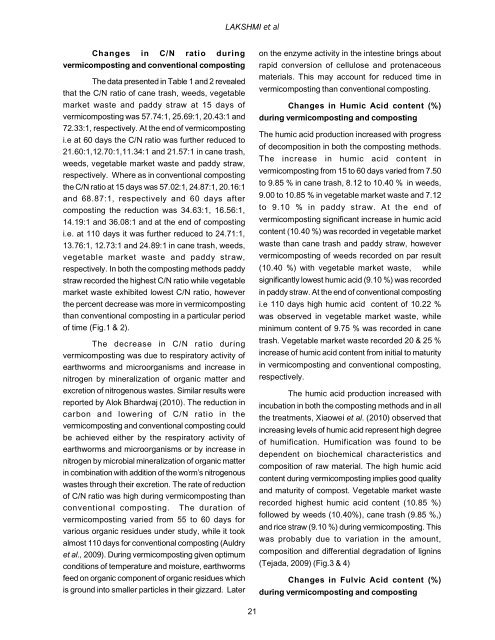The Journal of Research ANGRAU
Contents of 41(1) 2013 - acharya ng ranga agricultural university
Contents of 41(1) 2013 - acharya ng ranga agricultural university
You also want an ePaper? Increase the reach of your titles
YUMPU automatically turns print PDFs into web optimized ePapers that Google loves.
LAKSHMI et al<br />
Changes in C/N ratio during<br />
vermicomposting and conventional composting<br />
<strong>The</strong> data presented in Table 1 and 2 revealed<br />
that the C/N ratio <strong>of</strong> cane trash, weeds, vegetable<br />
market waste and paddy straw at 15 days <strong>of</strong><br />
vermicomposting was 57.74:1, 25.69:1, 20.43:1 and<br />
72.33:1, respectively. At the end <strong>of</strong> vermicomposting<br />
i.e at 60 days the C/N ratio was further reduced to<br />
21.60:1,12.70:1,11.34:1 and 21.57:1 in cane trash,<br />
weeds, vegetable market waste and paddy straw,<br />
respectively. Where as in conventional composting<br />
the C/N ratio at 15 days was 57.02:1, 24.87:1, 20.16:1<br />
and 68.87:1, respectively and 60 days after<br />
composting the reduction was 34.63:1, 16.56:1,<br />
14.19:1 and 36.08:1 and at the end <strong>of</strong> composting<br />
i.e. at 110 days it was further reduced to 24.71:1,<br />
13.76:1, 12.73:1 and 24.89:1 in cane trash, weeds,<br />
vegetable market waste and paddy straw,<br />
respectively. In both the composting methods paddy<br />
straw recorded the highest C/N ratio while vegetable<br />
market waste exhibited lowest C/N ratio, however<br />
the percent decrease was more in vermicomposting<br />
than conventional composting in a particular period<br />
<strong>of</strong> time (Fig.1 & 2).<br />
<strong>The</strong> decrease in C/N ratio during<br />
vermicomposting was due to respiratory activity <strong>of</strong><br />
earthworms and microorganisms and increase in<br />
nitrogen by mineralization <strong>of</strong> organic matter and<br />
excretion <strong>of</strong> nitrogenous wastes. Similar results were<br />
reported by Alok Bhardwaj (2010). <strong>The</strong> reduction in<br />
carbon and lowering <strong>of</strong> C/N ratio in the<br />
vermicomposting and conventional composting could<br />
be achieved either by the respiratory activity <strong>of</strong><br />
earthworms and microorganisms or by increase in<br />
nitrogen by microbial mineralization <strong>of</strong> organic matter<br />
in combination with addition <strong>of</strong> the worm’s nitrogenous<br />
wastes through their excretion. <strong>The</strong> rate <strong>of</strong> reduction<br />
<strong>of</strong> C/N ratio was high during vermicomposting than<br />
conventional composting. <strong>The</strong> duration <strong>of</strong><br />
vermicomposting varied from 55 to 60 days for<br />
various organic residues under study, while it took<br />
almost 110 days for conventional composting (Auldry<br />
et al., 2009). During vermicomposting given optimum<br />
conditions <strong>of</strong> temperature and moisture, earthworms<br />
feed on organic component <strong>of</strong> organic residues which<br />
is ground into smaller particles in their gizzard. Later<br />
on the enzyme activity in the intestine brings about<br />
rapid conversion <strong>of</strong> cellulose and protenaceous<br />
materials. This may account for reduced time in<br />
vermicomposting than conventional composting.<br />
Changes in Humic Acid content (%)<br />
during vermicomposting and composting<br />
<strong>The</strong> humic acid production increased with progress<br />
<strong>of</strong> decomposition in both the composting methods.<br />
<strong>The</strong> increase in humic acid content in<br />
vermicomposting from 15 to 60 days varied from 7.50<br />
to 9.85 % in cane trash, 8.12 to 10.40 % in weeds,<br />
9.00 to 10.85 % in vegetable market waste and 7.12<br />
to 9.10 % in paddy straw. At the end <strong>of</strong><br />
vermicomposting significant increase in humic acid<br />
content (10.40 %) was recorded in vegetable market<br />
waste than cane trash and paddy straw, however<br />
vermicomposting <strong>of</strong> weeds recorded on par result<br />
(10.40 %) with vegetable market waste, while<br />
significantly lowest humic acid (9.10 %) was recorded<br />
in paddy straw. At the end <strong>of</strong> conventional composting<br />
i.e 110 days high humic acid content <strong>of</strong> 10.22 %<br />
was observed in vegetable market waste, while<br />
minimum content <strong>of</strong> 9.75 % was recorded in cane<br />
trash. Vegetable market waste recorded 20 & 25 %<br />
increase <strong>of</strong> humic acid content from initial to maturity<br />
in vermicomposting and conventional composting,<br />
respectively.<br />
<strong>The</strong> humic acid production increased with<br />
incubation in both the composting methods and in all<br />
the treatments, Xiaowei et al. (2010) observed that<br />
increasing levels <strong>of</strong> humic acid represent high degree<br />
<strong>of</strong> humification. Humification was found to be<br />
dependent on biochemical characteristics and<br />
composition <strong>of</strong> raw material. <strong>The</strong> high humic acid<br />
content during vermicomposting implies good quality<br />
and maturity <strong>of</strong> compost. Vegetable market waste<br />
recorded highest humic acid content (10.85 %)<br />
followed by weeds (10.40%), cane trash (9.85 %,)<br />
and rice straw (9.10 %) during vermicomposting. This<br />
was probably due to variation in the amount,<br />
composition and differential degradation <strong>of</strong> lignins<br />
(Tejada, 2009) (Fig.3 & 4)<br />
Changes in Fulvic Acid content (%)<br />
during vermicomposting and composting<br />
21

















